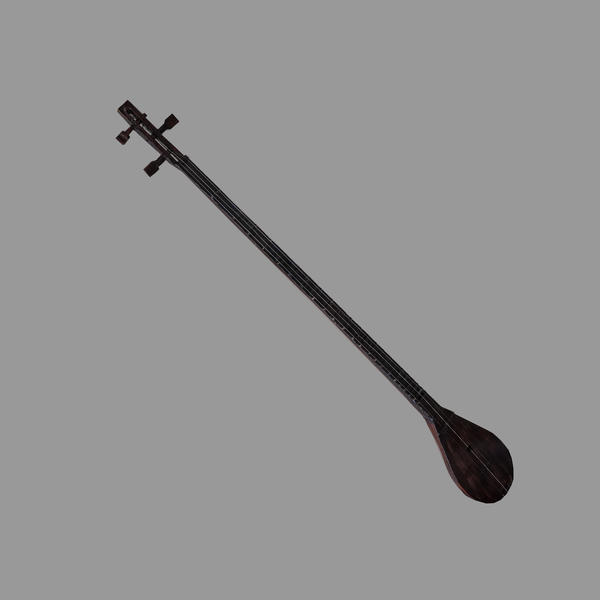This exhibit item is a reconstruction of a medieval Tatar musical instrument from the times of the Golden Horde and Kazan Khanate — a dombra.
Dombra is a fretted instrument popular with Kazakh, Kalmyk and other people, a traditional example of Turkic culture.
From the old times, the technique used for making this instrument was slotting from a single piece of wood. The artisans used different types of wood found locally. The most popular were maple, willow, acacia, mulberry and apricot.
Dombra has a rather simple structure: a body, a neck and a peg box. Modern instruments have triangular shape; the pear-shaped ones are becoming rarer and rarer. Two strings are tightened along the neck; they are the source of the sound. Traditionally, they were made from sheep casing; the casing of a two-year old sheep were believed to be the best material: they produced low deep sound, characteristic of folk music.
The string from casing are endurable and go out of service very quickly, hence, modern instruments have nylon strings. Unfortunately, they do not fully convey the original audio quality. Strings from casing are still installed on the old dombras during restoration; they are made strictly according to the old Kalmyk technique.
At the bottom, the strings are attached to a button on the body, and at the top, they are bundled up to the tuning pegs used for tension adjustment and master tuning. The foot of the dombra is also very important: the sound of the instrument changes depending on whether the foot is closer or further from the neck.
Dombra is a fretted instrument popular with Kazakh, Kalmyk and other people, a traditional example of Turkic culture.
From the old times, the technique used for making this instrument was slotting from a single piece of wood. The artisans used different types of wood found locally. The most popular were maple, willow, acacia, mulberry and apricot.
Dombra has a rather simple structure: a body, a neck and a peg box. Modern instruments have triangular shape; the pear-shaped ones are becoming rarer and rarer. Two strings are tightened along the neck; they are the source of the sound. Traditionally, they were made from sheep casing; the casing of a two-year old sheep were believed to be the best material: they produced low deep sound, characteristic of folk music.
The string from casing are endurable and go out of service very quickly, hence, modern instruments have nylon strings. Unfortunately, they do not fully convey the original audio quality. Strings from casing are still installed on the old dombras during restoration; they are made strictly according to the old Kalmyk technique.
At the bottom, the strings are attached to a button on the body, and at the top, they are bundled up to the tuning pegs used for tension adjustment and master tuning. The foot of the dombra is also very important: the sound of the instrument changes depending on whether the foot is closer or further from the neck.
Despite such a small number of strings, the virtuoso dombra players impress their audience with the beautiful and sophisticated melodies. This instrument looking so simple at first sight is capable of to convey the deepest feelings of a human soul.
Not a single ceremony went without a dombra; it accompanied the singsongs of Qissa-i Yosif and Kutadgu Bilig. The unique melodies call the associations with the rustle of grass, tinkling of creeks, jubilation of birds, whickering of horses and clatter of their roofs. The tradition prescribed playing dombras before a battle to bring the warriors into brave spirit.
With time, the methods of making the instrument changed gradually with the purpose of improving the acoustic qualities and to increase the durability. Modern dombras are made of separate glued pieces, and the artisans choose hardwoods — pine tree, larch tree, and fir tree.
Not a single ceremony went without a dombra; it accompanied the singsongs of Qissa-i Yosif and Kutadgu Bilig. The unique melodies call the associations with the rustle of grass, tinkling of creeks, jubilation of birds, whickering of horses and clatter of their roofs. The tradition prescribed playing dombras before a battle to bring the warriors into brave spirit.
With time, the methods of making the instrument changed gradually with the purpose of improving the acoustic qualities and to increase the durability. Modern dombras are made of separate glued pieces, and the artisans choose hardwoods — pine tree, larch tree, and fir tree.



